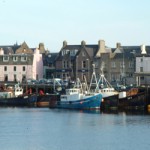- State-of-the-art fuel monitoring system to be installed on all major CalMac vessels – the first UK ferry operator to roll out such a system across so much of its fleet
- Substantially improving green credentials with reduced carbon emissions in line with National Transport Strategy and CalMac’s commitment to the sensitive marine environment in Scotland
- Conservative estimates also show that the system will show more than £450,000 annual savings to the taxpayer
- The advanced system uses fuel monitoring sensors which are linked to touchscreen displays on board, feeding information back via cloud technology to real-time systems in head office
- Announcement warmly welcomed by Minster for Transport and Islands
Caledonian MacBrayne is leading the UK’s ferry operators by installing an innovative and advanced fuel monitoring systems (FMS) in all 10 of its major vessels.
The move will lead to significant environmental and economic benefits with a minimum two per cent fall in greenhouse gas emissions and fuel expenditure – a tangible commitment to Scottish Government’s National Transport Strategy.
Conservative indications are that fuel savings of more than £0.45 million per annum will be made and CO2 emissions will be cut by some 1,800 tonnes, which is equivalent to the annual greenhouse gas emissions of 4,285,714 miles driven by an average passenger car, or 645 tonnes of waste sent to landfill. The £0.45m installation cost will be recouped in a year.
Eight of the 10 vessels now have the system installed as part of what is known as Project Ecoship – the remaining two will be fitted during annual maintenance periods.
The first ship to receive the new system was MV Caledonian Isles on the Ardrossan to Brodick route and data in the first couple of months does support the company’s aims to cut emissions by two per cent. Indeed figures suggest that the 22-year-old vessel could be on target to save well in excess of the target, alone contributing an annual reduction of 624 tonnes CO2 emission based on current trends.
Smart technology links sensors on the vessels’ engines to a touch screen display in both the bridge and engine room. The ship’s master and chief engineer are able not only to monitor fuel consumption in line with speed and power, but are also able, in real time, to identify any engine variations as they occur and make adjustments as appropriate.
Data output is also immediately available for each separate vessel in the fleet, together with location, at the company’s headquarters where analysis over time will correlate complex links with weather, tidal and loading conditions, speed across the water, vessel adjustments and sea state to build a fuller picture.
Vessels also share a data noticeboard in the cloud where results can be compared and analysed, with crews learning from one another and sharing knowledge.
Early trials, pre-installation roll-out, on two of CalMac’s vessels also indicated that it could outstrip the predicted two per cent – possibly up to six per cent on some vessels and routes.
The ships involved in the trial represented an age cross-section of the CalMac fleet, with the 17-year-old MV Clansman and four-year-old Finlaggan chosen to take part.
While Clansman’s savings were, indeed, in the order of a little more than two per cent, Finlaggan, as a newer ship with more modern technology on board, was more than double that on 6.5 per cent.
Minister for Transport and Islands Derek Mackay MSP said: “I warmly welcome the launch of Project Ecoship, which once again shows CalMac is at the forefront of ferry innovation.
“This state-of-the-art technology has the potential to have a significant impact on the fleet’s emissions, cutting its carbon footprint in some of Scotland’s most striking coastlines and sensitive marine environments.
“As well as the environmental benefits, it will also save money for the taxpayer by helping cut down on the amount of fuel used by the vessels.
“I congratulate CalMac on the success of the project so far, delivering environmental and financial results, and look forward to seeing this new technology in action on more of our ferries in the future.”
“Our commitment to the taxpayer and the environment has come together with Project Ecoship,” said CalMac’s technical director Peter Breslin. “The fuel monitoring systems have only recently been installed on our vessels and the project is in a bedding-in phase.
“But both early data and anecdotal feedback from the ships is encouraging and we expect to see significant benefits in due course both to our carbon footprint and our bottom line.
“For taxpayers and our shareholder, the Scottish Government, this has to be welcome news and is part of our on-going commitment to make energy and environmental improvements in line with the National Transport Strategy wherever possible.
“Environmental kindness and major shipping vessels may seem like unlikely bedfellows, but we are committed to taking steps to improve our green credentials as we pass through some of the least polluted and most unspoilt areas in Europe during our day-to-day work.”
In basic terms, the Royston Enginei system uses electronic touchscreen displays mounted on the bridge and in the engine room linked to sensors which monitor fuel flow into both engines. The ship’s master and the chief engineer can monitor consumption in real time and, in due course, a database of fuel consumption can be matched up to parameters like weather, tidal and loading conditions, speed across the water, vessel adjustments and sea state to build a fuller picture. Crucially, a drop in fuel usage performance can be identified as it occurs and steps taken to make immediate improvements.
The information collected during each and every sailing is relayed back to head office in a continuous feed. Cross-referenced with prevailing conditions for each ship on the day, as well as the routes travelled, this data will rapidly build an accurate and useful picture of where further improvements can be made, as well as highlighting routes which could benefit from further scrutiny or a different approach. It can also help in targeting work plans and priorities for annual refit periods, as much more data about the engine performance will have been gathered.
Caledonian MacBrayne has been named Best Ferry Company at the inaugural Independent Travel Awards and was highly commended as Best Ferry Operator at the National Transport Awards.
The company is the operator of the UK’s largest ferry network. In 2014 alone it carried 4.65 million people, 1.1 million cars, 92,000 commercial vehicles and 11,000 coaches across its 200-mile long network straddling Scotland’s west coast.
Its 130,000 individual sailing per year operate on routes which traverse some of Europe’s most breath-taking and challenging stretches of water to provide lifeline services to remote communities on islands and mainland destinations.
// //
Hebrides Today brings you the latest news from the Western Isles




 Welcome
Welcome Double success for Gaelic radio at media awards
Double success for Gaelic radio at media awards Grant astonished at Allan’s hypocracy over ADS
Grant astonished at Allan’s hypocracy over ADS SHEPD invites island communities to make plans to weather the storms
SHEPD invites island communities to make plans to weather the storms Grant deeply concerned at suspension of Doighead respite service
Grant deeply concerned at suspension of Doighead respite service Scotland’s fishing industry ‘at mercy of a lottery of London priorities’ says MP
Scotland’s fishing industry ‘at mercy of a lottery of London priorities’ says MP Record year for regional airport operator
Record year for regional airport operator Follow the Queen’s example and visit the Isles, says MP
Follow the Queen’s example and visit the Isles, says MP
Leave a Reply